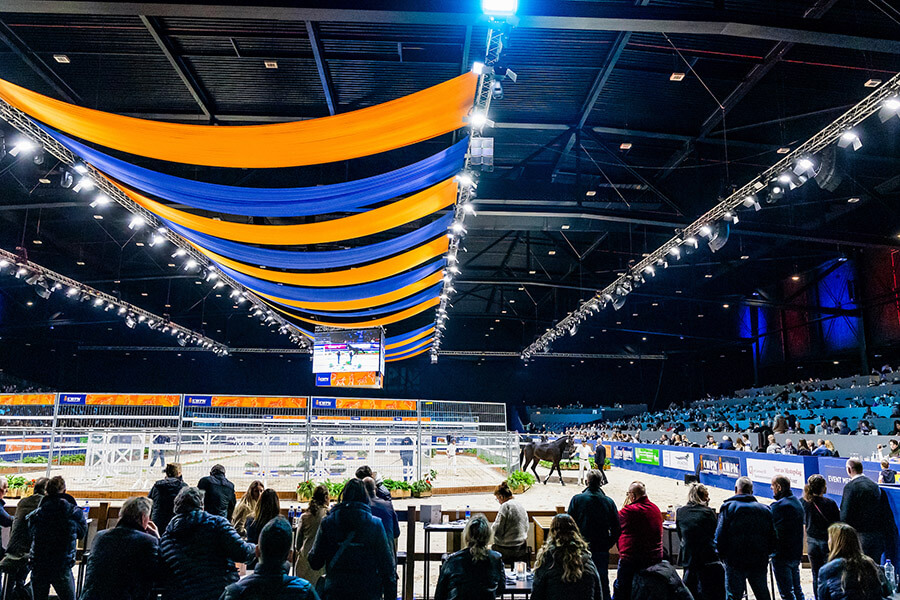Christopher Hector’s on-the-spot exclusive – photos Dirk Caremans and archive…
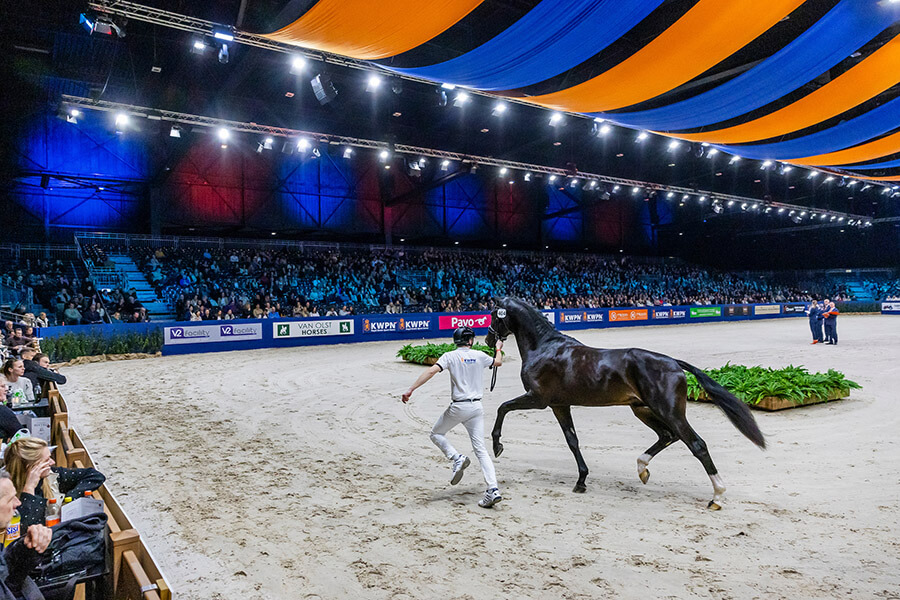
The stallion in the photo is Rohan (Jameson / Easy Game)
In the furore that has followed massive dressage scores for the two Charlottes’ riding horses with very short necks, there has been a platoon of keyboard warriors who seek to absolve the riders, and blame the Dutch breeders!
The truth is there to be seen in the ranks of the young stallions presented to the commission at this year’s KWPN Stallion Show, and while it is true that the influential Dutch stallion, Negro, has a tendency to throw a short neck, even a horse like Everdale, one whose conformation has been widely lambasted, has quite an adequate neck. Blame the rider, not the breeder.
It’s like being confronted with a buffet of the most fabulous food imaginable. These young stallions really are mouth-watering, one after another, youngsters that are as beautiful as they are athletic, they move move, move, move.
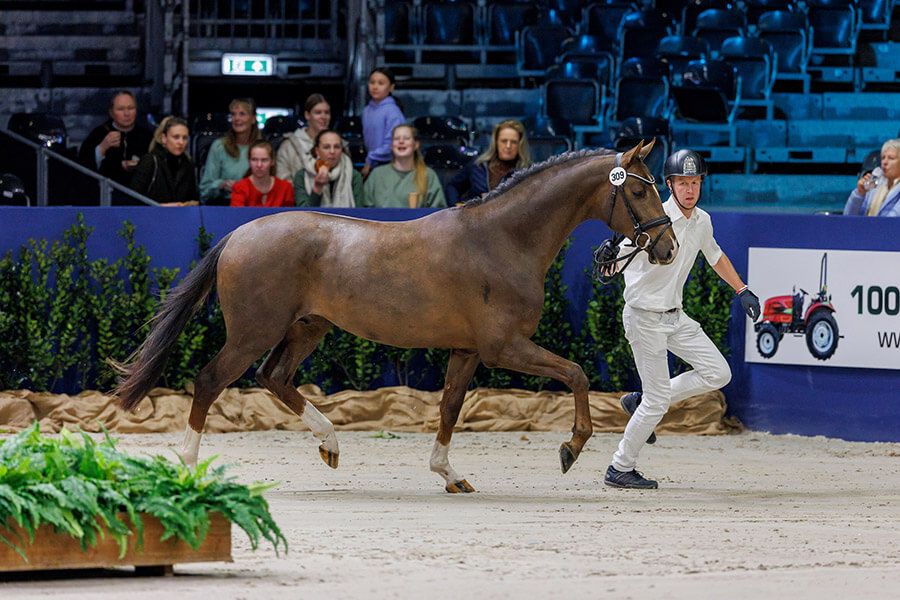
Brise – the ‘B’ line lives
The first out, Brise, is by Bonds, by Benicio out of a Sir Donnerhall I mare and she’s just one of many by Sir Donnerhall that turn up on the pedigrees of the colts that have made it through the preselection to this moment of truth. Brise is out of a mare by Vivaldi so he’s three quarters German bred, one quarter Dutch. fo the B colts, Only Reinberg JB, who is by the Bon Coeur son, Bloomberg, out of a Cachet L / Rubinstein mare, gets invited to go on to the performance test in Ermelo.
It would seem that the Dynamic Dream frenzy is dying down, there are only two of his sons in the line-up, and only one of them gains the Commission’s seal of approval. In Germany, the controversial stallion – he has never completed a performance test or the sports alternative – continues to dominate the scene. Dynamic Dream was the most popular stallion in Oldenburg in 2022, and in 2023 was the best represented at both the Westfalen and Hanoverian Licensings. Though some of the gloss came off when a Dynamic Dream / Millenium colt at Hannover, proved positive to an anti-inflammatory, recalling Dynamic Dream’s own drama at his first licensing attempt in 2019, when he lost his Westfalen Championship and his license, when he too proved positive to the non-steroidal anti-inflammatory (NSAI) Flunixin.
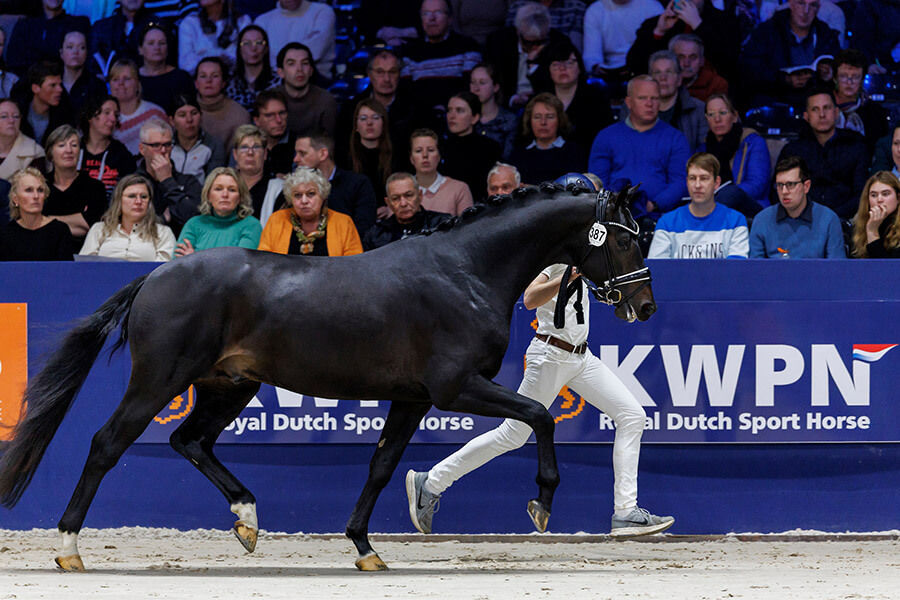
Rayano
Not surprisingly, Glamourdale (Lord Leatherdale / Negro) brought forward the largest group of colts – five – with one, Rayano (out of a mare by the Apache son, Cum Laude) one of five stallions awarded a premium. Bred by van Olst, this was an example of concentrated dressage blood, there’s two crosses of Glamourdale, two of Jazz, and one each of Ferro, Krack C, Weltmeyer and Rubinstein. The sire of the fourth dam is the first Dutch dressage stallion star, the Trakehner, Doruto.
Glamourdale is something of an exception to the current trend of breeding to young, untested stallions that produce pretty foals for immediate sale. He tends to throw his dam sire Negro’s short neck, but thankfully there are mare owners who care more about the black stallion’s international performance career, than following the whims of fashion.
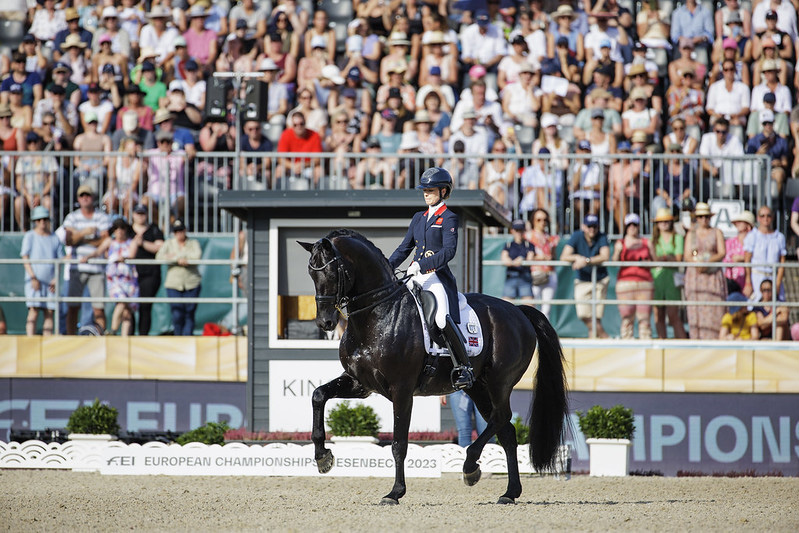
Glamourdale
My friend Jens Meyer who until the recent re-shuffle worked at Blue Hors as a special advisor, is one stern critic of the trend to fashion breeding, and he likes Glamourdale with his German / Dutch fusion. “I like the mix, we have the good back from the German horse, from the Dutch horses, we get the front technique and the canter. I use Glamourdale, this is a young top Grand Prix stallion and how many stallions do we have in the sport? Not many. People say he does not produce, type, he is not a refiner for sure, but he throws a healthy conformation. His foals are uphill, and with power in the body. Okay sometimes with the Negros they have a bit of a short neck but what is important in the end is that they are rideable. I hate it at the moment people just talk about problems with the stallions, not what they get from the stallion…”
Rayano fetched the top price of €130,000 at the KWPN auction, though I understand that unlike some of the other studbooks, the Dutch book is not dependent on auction earnings for its financial health, and an entry in the auction is not an aid to successful licensing.
So Perfect, by Sezuan (now gelded, by Grand Prix star, Zack, out of a Sir Donnerhall I / Rohdiamant mare) also sent five to den Bosch, but none were approved. Kjento (Negro / Jazz) also had five, with two approved, both out of Rousseau (Ferro / Roemer) mares.
There were four stallions each with three sons up for approval: Blue Hors Monte Carlo, For Romance, Sir Donnerhall I and Latanas.
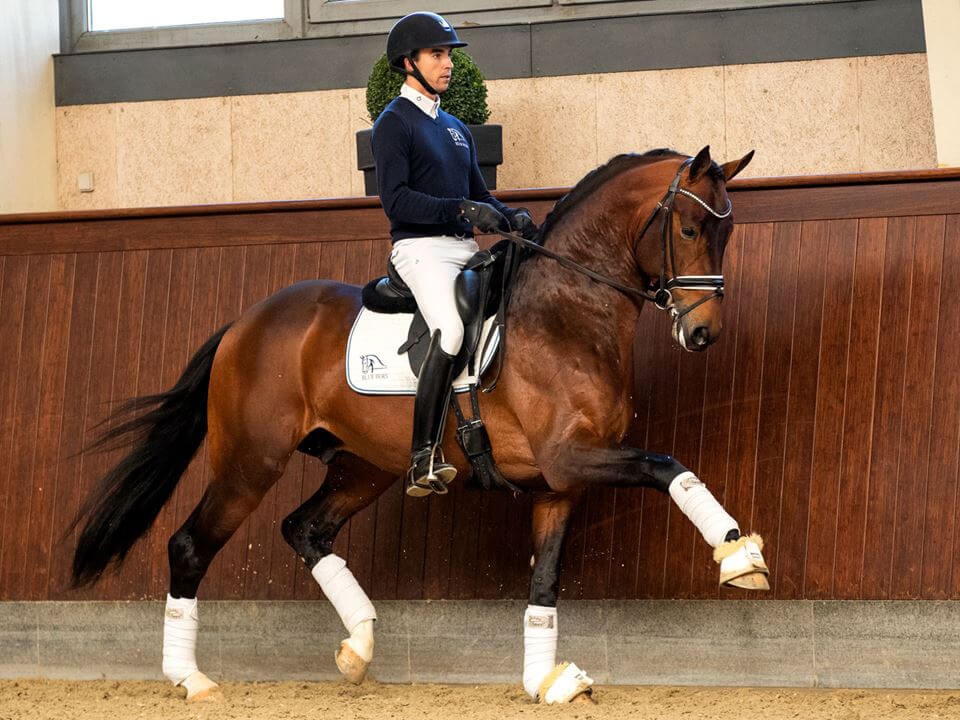
Monte Carlo
Blue Hors Monte Carlo had a good show with two of his three approved, out of Florencio and Daily Diamond mares. Monte Carlo is by Dream Boy out of a United mare.
With Monte Carlo, once again, Blue Hors has willfully tacked their prefix on a horse that has nothing to do with their breeding, though the TC suffix tells the real story, since it indicates that the stallion is the product of the breeding program of one of Holland’s premier breeders, Tim Coomans.
Coomans bred the sire of Monte Carlo, Dream Boy. He was crowned KWPN breeder of the year in 2012. Interviewed by the KWPN magazine at the 2024 World Young Horse Championships, he outlined his philosophy:
“Horse people are not born, they are made. By trial and error, by making mistakes, taking out the positives and continuing ‘with the horses’, these people built up an enormous amount of knowledge.”
The most important horses for him?
“Jazz has done an incredible amount of good for breeding, but at the time those were not horses for amateurs. I still absolutely love Contango in the dam line, He produced strength and hard workers. They didn’t always win a beauty contest, but they were such fine horses to ride.”
Latanas is not exactly a household name but if he keeps going like this, he may become one, his three were all approved, with one, out of a Negro mare taking home a Premium sash. The stallion is not what you’d call fashionably bred. He is by Sir Donnerhall I (not a noted stallion maker), out of a mare by the jumping Holsteiner, Hemmingway (his pedigree boasts both Landgraf and Ramiro), with more jump on the next line, through 1.50 jumper, Zuidhorn.
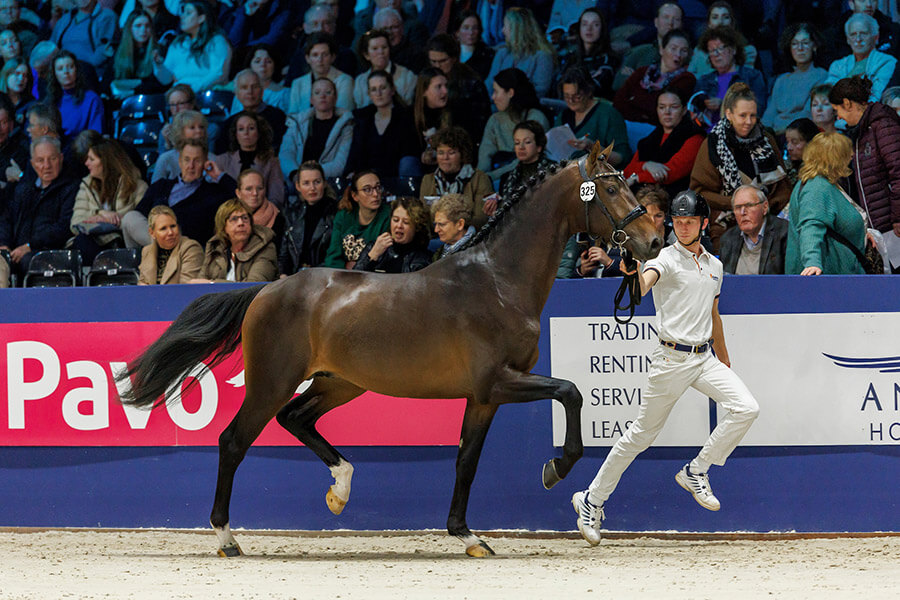
Rockstar Millionaire
A premium also went to Joop van Uytert’s Rohan (Jameson / Easy Game) along with another of his team, Rome USB (Vaderland / Zambuka). The fifth premium was awarded to Rockstar Millionaire (D’Avie / Sandro Hit).
I suggested to Floor Drooge (who once again enlivened the look of the Commission with a pair of bright orange stilettos) that in their Premium selection they had quite a mix, Glamourdale, Monte Carlo even Vaderland were all fairly predictable but we were stepping into slightly stranger territory with Lantanas and D’Avie…
“What do you mean with ‘stranger territory’? The horses you were seeing or the fathers…”
The bloodlines. If we look at D’Avie, we are looking at Don Juan, Londonderry, Walt Disney, not a famous combination…
“Okay, but for us it is different blood, so then the level of in-breeding in the population, is lowered, that’s a good thing, and the dam line is a really strong dam line with a lot of sport horses in it, and in the end you are trying to select sporthorses. We also take the mother’s side of the pedigree, really into consideration.”
You are not worried by the very strong suspicion that Don Juan had shivers, and he bred a World Champion with shivers…
“If you suspect a horse has it, you have to see for sure if the horse has got it, but for now we picked this horse and it is going to do the test where we will see the horse under saddle, and get a clinical review by the vet and we’ll know how it is. But if we don’t select it now because of the blood line and it doesn’t have this problem, then we threw that stallion away.”
And the other one, Lantanas, I saw his sire, Sir Donnerhall at the Bundeschampionate, that was his only competition, he was slow and out behind, and he’s got that weird Danish harness horse blood in his background, but his name keeps popping up on the pedigrees of nice horses…
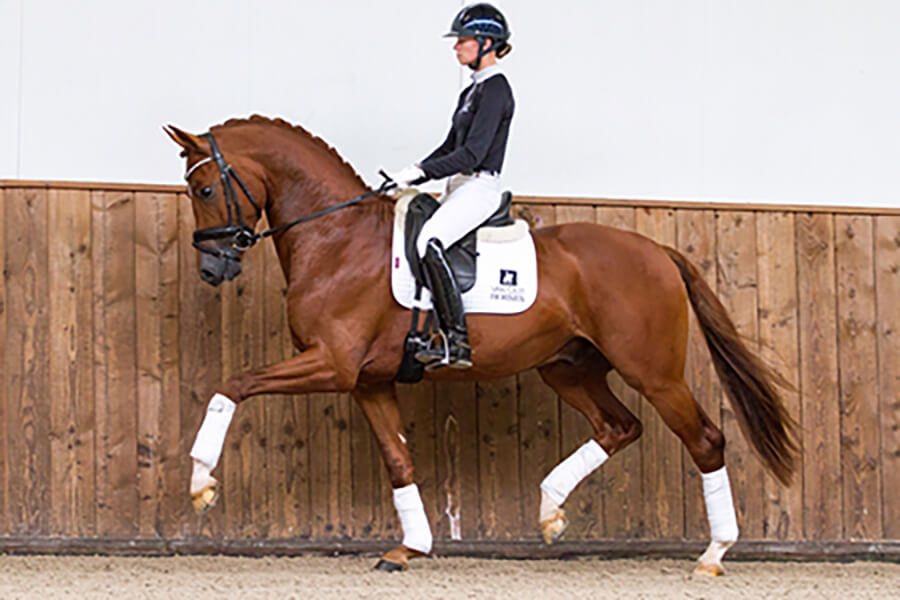
Lantanas
“That’s why you just have to test it and see it, and we really really like this horse, so you don’t let that influence you, and you take the horse. And in the end, the dam line of Lantanas is a really good one with Grand Prix horses, and you take that into consideration as well.”
Jameson had a premium and several accepted, I’ve always been in love with that horse, what do you think he is putting on his progeny?
“I think we are seeing horses, where the parts of the body are very good, they are even and the connection is good, although he, himself, is slightly down in the topline. Look at Proud James, the high scorer we had in the Fall in the performance test, he’s got the body of a riding horse, the connections are really really strong, the hind is built under the body instead of what we sometimes see, longer behind. And in the end, that makes it so much easier. He was in the test for twenty-one days, and every day he was the same. Every day easy to ride, you could put him a little lower, or up and he was the same. In the end, you are shooting for horses with the conformation that makes it that easy. If it’s that easy, we’re still riding them in twenty years.”
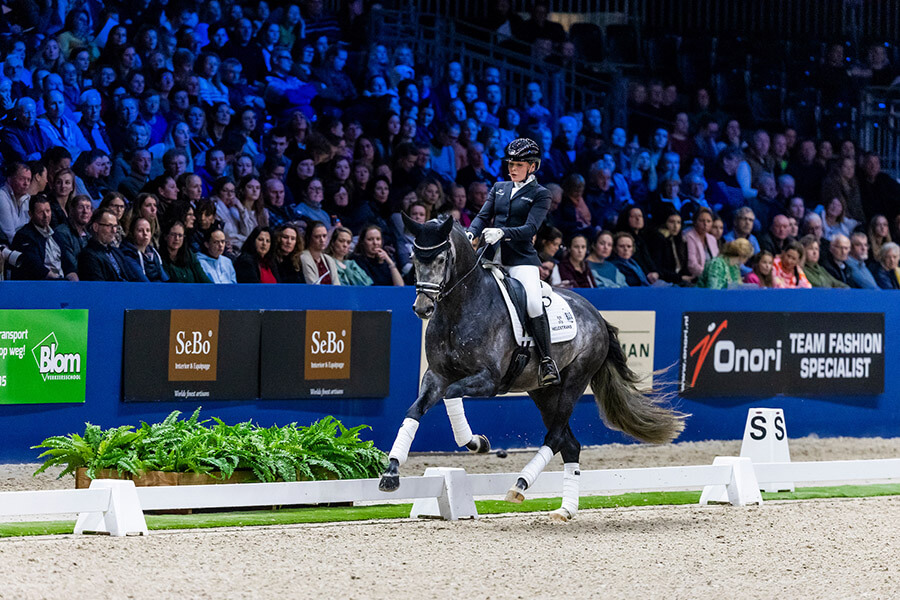
Proud James, Performance winner
Vaderland, he’s a new stallion for you, what do you think he offers?
“For us it is a new horse, but nothing new in blood, we have that blood.”
You sent that blood away! (his sire, Vitalis was repeatedly rejected by the KWPN)
“We took it back later, sometimes you have to say, come back, the door is never closed. We saw offspring by Vaderland from yearlings to three years old, and you see a lot of Contango in the foundation, really solid, with good bones, good feet underneath, and I think nowadays with the modern horses we can use that a bit again. The topline was good, and, of course, the Vitalis front, it’s nice in the neck and the head. It was really remarkable, they took the offspring out of the groups and put them in the stables, and the next day they were walking up to us, they didn’t run away from us.”
“And that’s the same with Vaderland, if you saw him today with Dinja, for sure sometimes he was a bit impressed because the audience was liking it, but the whole time you could see his ears, like a little antenna, asking, is it good, what do you want me to do? Are we still a partnership, are we still in the team? It’s so good if they have that mindset. Okay he is from Vivaldi and Vitalis, but we hope he will pass it on as well.”
Did you have…
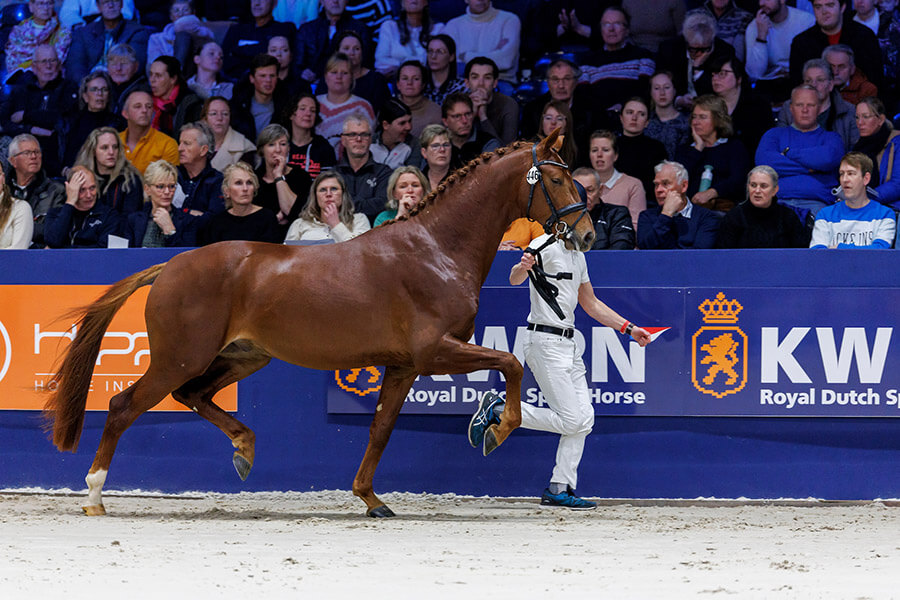
Rumble VDK, the Lantanas colt out of a Negro mare
“A personal favourite, ha ha! Oooh, I really like the Lantanas, because I like it when the horse is that athletic in his body, and I like it when it is always going in power with a lot of mechanics. But then I see the Vaderland which is really nice, so much ease in the movements. You can name like five, six, eight, that have really good things, but in the end my real favourite will be the one that is top under saddle, and fits my mare. You have to wait for the test, you have to…”
At this point we were joined by the new head of the dressage commission, Bart Bax, and in the tradition of his predecessor Bert Rutten, Bart is Grand Prix competitor:
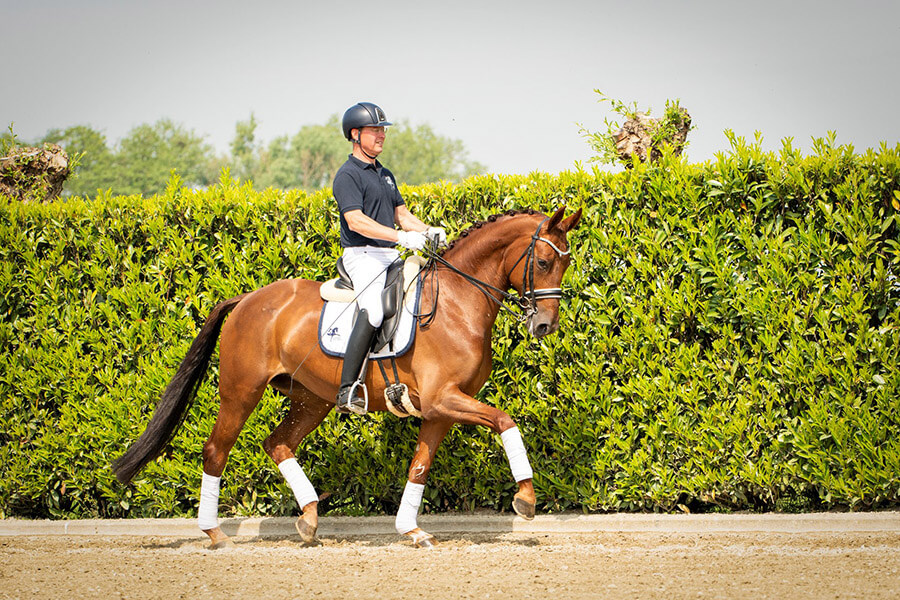
Bart Bax
“At home I have a dressage stable, I do a lot of judging, up to Grand Prix level. I competed on the World Cup circuit in 2006 and 2007, and at that time I was selected in the B cadre for the Dutch Team.”
One of the things Bert Rutten was very strong on, was that if you want to breed a Grand Prix horse, you need a stallion that has competed Grand Prix. But when I look at your Premium stallions, only one is by a Grand Prix horse, Glamourdale, D’Avie, Grand Prix maybe…
“I know what you mean, but if you want to give the young stallions a bit of a chance, when they have a good young horse, we try to test them. It’s right what you say, when you have a Grand Prix father and a Grand Prix mother, then you have more of a chance, but I think it is good to give a chance to the younger stallions.”
Floor joined us:
“Glamourdale is doing a really good Grand Prix, D’Avie is doing Grand Prix, Jameson is getting close to it, Vaderland we saw, so that will work as well. Then we only have Lantanas and he’s got Grand Prix genes as well.”
You say it is good to give the young stallions a chance, but surely one of the biggest problems we have in dressage today, is that the mare owners only go to the new, young sires, and ignore the older proven stallions…
Bart: “Yeah, I know what you mean, but I think it is very important to look to your mare and see what your mare does, and look to the pedigree of your mare, and if there are many successful competitors on it, then you can easier use the young horses.”
You don’t see it as a problem that the young stallions are getting many more mares than the older ones?
Floor: “It depends a bit on how strong the dam line is. If you have a dam line with a lot of genetically interesting horses, it’s easier or safer to take a young stallion. If you look at today’s Grand Prix horses, a lot of them were made when their father was quite young. Sometimes you have to look at the pedigree, look at the horse, and make the good combination. For sure, we shouldn’t forget the old ones. We didn’t make the videos for nothing, it is important for people to see the older stallions, and use them. Sometimes it is easier to breed with the older ones because you know exactly what they give, but it in the end if you want to keep on making progress, then you need to use the young stallions as well. For the dressage, we should really try not to forget the old ones, and the jumpers should pay a bit more attention to the young ones. The truth is in the middle.”
Looking at what you saw over the two days, what did you find pleasing, what might have been better?
Bart: “You are looking a little to test the character, and with some horses we were looking for the suppleness of the back, some horses could have been more supple. There are many horses that do it good, but some need more suppleness.”
Bart, here’s the same unfair question as I asked Floor, pick your favourite…
“I think the Vaderland made a very big progress, from the beginning of the day to the end of the day. I think it’s good when a horse grows in his work. But I think all the five horses are good horses.”
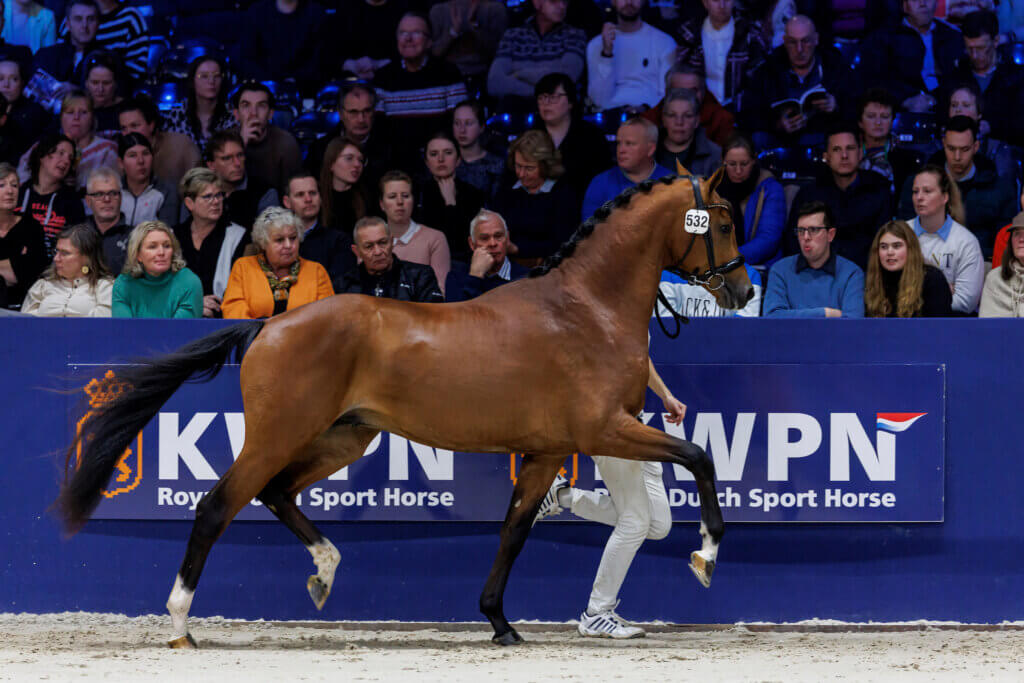
The Vaderland, out of a Zambuka mare
Floor: “On the other hand if you saw the Glamourdale / Cum Laude in the auction going around and around and around, he got better and better. When they have that, when they keep on using their body, and have energy, that’s really nice.”
Bart: “I think that’s very important in a dressage horse, that he is growing in his teaching, growing in his work.”
Floor: “For Championships you need a horse that does his best on the last day…”
Thank you both!
Joop van Uytert is one of the world’s most successful stallion keepers, and he enjoyed his time at the stallion show:
“We had four accepted, and we have two stallions in the premium ring, that’s really good. The first was the Jameson / Easy Game / Donnerhall, and the Donnerhall mare was the grandmother of Bordeaux. Bordeaux is United, Gribaldi, Donnerhall, that’s the same Donnerhall mare, from the Angelo xx line through the dam of Rembrandt, Adone.”
“The other one was the Vaderland out of the Zambuka. What is really nice with that pedigree, is that Vaderland needs a bit of blood, and by Zambuka you have Scandic and the power and the beauty of the Trakhner stallion, Biotop. Then there’s Sultan and he was a really nice type, years ago. In the end, that’s a really nice combination, we like that horse, really really really much.”
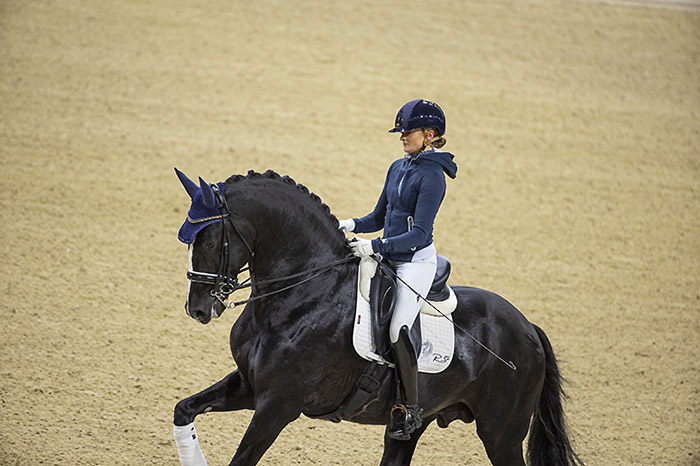
Jameson
What do you think Jameson is putting on his progeny?
“He had a lot of chances in breeding and until now it is a bit difficult to say because the oldest are now four. Last year they say, it could be a bit better, but you see Proud James, he is the premium stallion, and he makes a really good performance test. Jameson also gives last year, the national mare winner, and this year we had four or five really nice ones on the stallion show and two were accepted.”
And the sons that were here, they have a better walk than Jameson, that’s good breeding…
“Our stallion we have, out of the Easy Game, he has a huge walk, we are satisfied with that.”
Blue Hors Monte Carlo, he had two stallions accepted, what does he offer?
“The most breeding was in Denmark, and in Holland there were only ten foals, five or six stallions – three to the stallion selection, two accepted. It’s magnificent!”
What is the market like for you?
“The market for normal horses is really ‘normal’. The exceptional good ones, there’s no problem, but the normal you cannot sell easy.”
Another friend that I always seek out is Eugène Reesink. The Dutch breeder is one of the most informed individuals I have ever met. He was very proud because he had brought his exciting young stallion Vaderland (Vitalis / Krack C) to den Bosch, to have him approved by the KWPN.
“In forty-five minutes he will be here, and then we hope they will approve him.”
Why hasn’t he been approved in the past?
“He has an Oldenburg brand. He was standing in Germany, and bred quite a number of mares in his first years in Germany, not many in Holland. He is going well in the sport now, so we thought it was the time to present him in Holland. We want to have him at our place, so Dinja can ride him, and it will be easier to send the semen to the Dutch breeders now.”
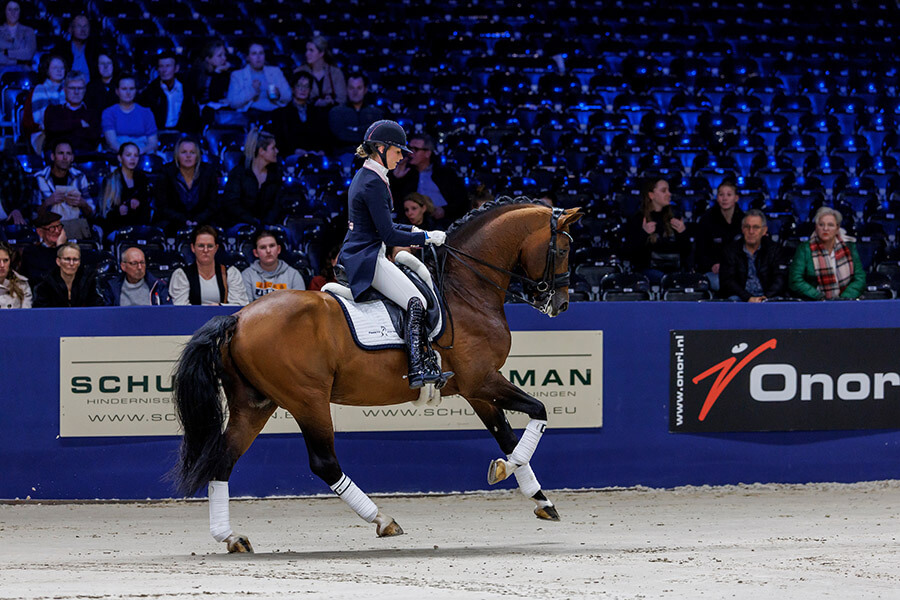
Vaderland
What do you think he is putting on his progeny?
“Super, super temperament, hot but in a positive way, no, hot is not the right word, forward thinking, not spooky, just doing his job. And a lot of presence – if you see a Vaderland, you will recognize him nearly immediately because they have a lot of presence. I remember when Vaderland was two and a half years old, a breeder came to our place wanting a stallion, he looked in the barn, but I said there is a better one out in the field, he’s the king in the field. He looked, and straight away said that’s the one!”
What do you think we’ve learned from the stallions we have seen over the past two days, where are the strengths, where are the weaknesses in dressage breeding in Holland right now?
“The strong part is that we have a big group of horses with a real good hind leg. Gert-Jan van Olst had some really good stallions, really, really good sons of Glamourdale, two or three by Kjento, Lantanas, real good. They all had a really good hind leg, the hind leg you need to carry the weight. And to be honest, I didn’t see a general weakness.”
I know you like him because you’ve told me before you like Sir Donnerhall and I can’t work out why. I saw Sir Donnerhall when he won at the Bundeschampionate, flat behind, out behind, he’s done a Novice Test, never done a Grand Prix…
“I think I told you I like Sir Donnerhall in the mother-line, and you see how many top horses are out of Sir Donnerhall mothers, it’s amazing.”
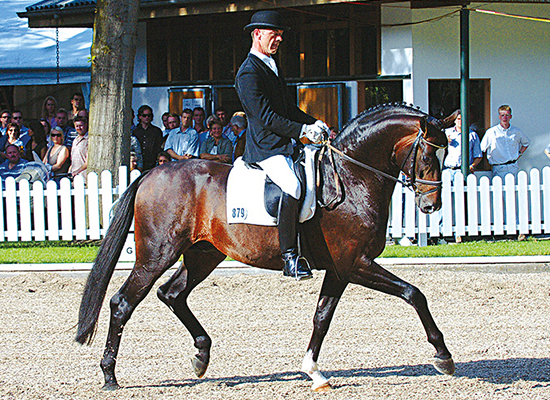
Sir Donnerhall I
But why, that’s what I can’t understand?
“We had exactly the same discussion. How is it possible? Our conclusion, I don’t know if it is right, Sir Donnerhall gives real pretty horses and a nice temperament as well, with a lot of expression in the conformation, especially in the neck and the head, and he gives a lot of shoulder freedom and if you mix that with a stallion who is powerful and good enough from behind, you can have a super nice offspring. That’s the only explanation we have, because we can’t find out exactly.”
“I think we have talked before about ‘freaks’ , how some top stallions have something really really special, and the special thing of Sir Donnerhall is his neck, his shoulder, his head. If you can keep this, and make a better hind leg, then you have a great horse. There are stallions that are not perfect horses, but they have something special, and if a horse has something special, you can make steps forward. But I hear what you are saying, and I am not sure of my answers about Sir Donnerhall, I still like him in the mother line but I can’t give an explanation.”
It was interesting, earlier today I looked at the stats for Sir Donnerhall I, and you see he has 70 Grand Prix dressage progeny, but if you look at the results they are all crap. The most famous is the one out of Weihegold, and that was getting 30% in Grand Prix, when they went St George, then gave up! One of the top three was competing in Wellington, it had three starts, and was eliminated in two, and scored 48% in the other – and that’s a ‘Grand Prix’ horse!
“Sir Donnerhall is not the best producer, that’s why I am surprised how well he does on the motherline, because I’ve had really a lot of good horses out of Sir Donnerhall mares.”
“I’m not sure how many they approved here, 40?, but only fifteen or twenty will be approved after the performance test. This is just half of the selection. In Germany they can do a two or three day test, and start to breed already as a three year old, in Holland, they start to breed after the three weeks test, and only between fifteen and twenty will pass. From here they are allowed to go to the test, but they are not approved yet, there is a long way to go.”
It was interesting that while Dynamic Dream is dominating in Germany still, here he seems to have disappeared?
“In Germany they approved ten, here there were two, they approved one, out of a Vitalis mare. Dynamic Dream is a bit like a lot of horses, a bit of hype, and in the dressage world, a lot of stallions are hyped. So Perfect wasn’t, so perfect today, I understand totally why the judges didn’t take any of his offspring – that was also hype, So Perfect was really popular in Holland, I think he bred more than Dynamic Dream in Holland.”
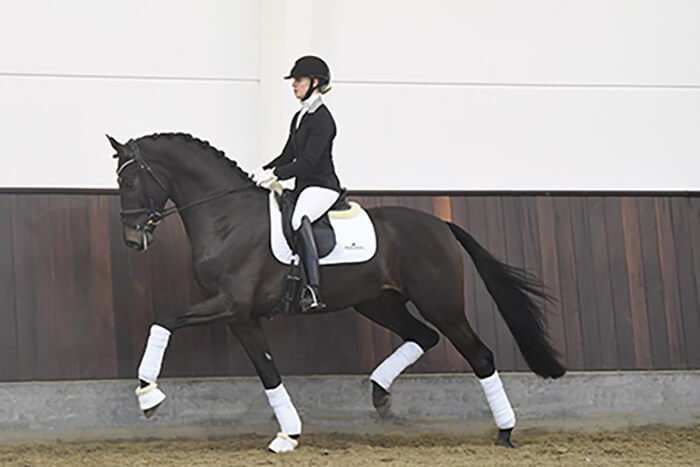
So Perfect
Are you worried about the number of mares going to the young ‘fashion’ stallions, and not to older stallions who have already proved what they can do?
“I think in general, that’s a big mistake, because if you have a stallion that has proven he has good offspring and because of his age, they don’t use him any more, I don’t know why, but dressage breeding is really hype. Young stallions are breeding two hundred, four hundred, six hundred mares, it’s crazy in my opinion. In the jumping, it’s the other way round.”
In the jumping, they won’t breed to the younger stallions…
“There they have to jump 1.60m, then they start breeding, in dressage it is mostly the youngsters, and that is not good.”
Where does your breeding program go, are you looking for new blood?
“For us, what we are looking for, as it should be, a double function, a top sporthorse and a breeding stallion. Like Vaderland, Vaderland, has won as a seven-year-old, Prix St Georges international, with 76%, that’s as important for us, as he is as a breeding stallion, the stallion should be a good sporthorse. I don’t go for horses only for breeding, sporthorse is really important for us.”
And thank you all the people who took time to answer my questions, mostly thank you to the Dutch breeders for producing such wonderful horses – and the KWPN team for such a great show…
